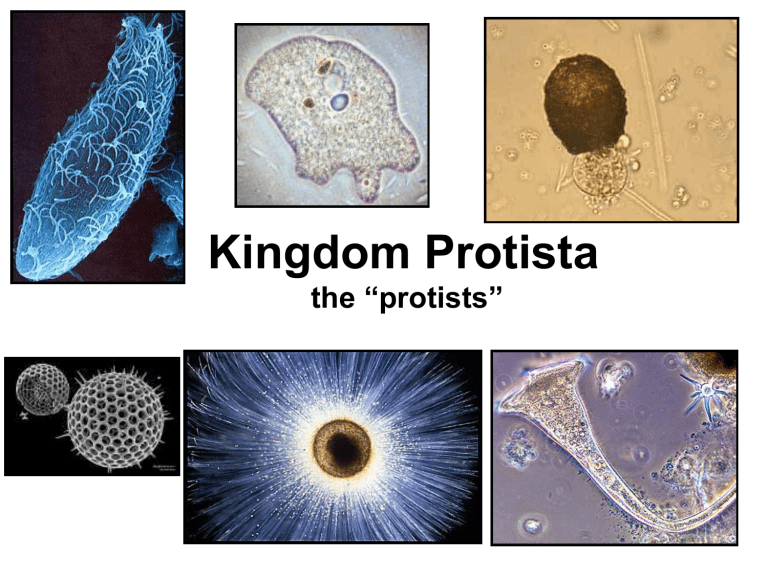Phylum Mollusca

Kingdom Protista the “protists”
Protista Characteristics
Triploblastic
Organ level of organization
Cephalization
Eucoelomate
Deuterostome
Kingdom Protista
Unicellular
Microscopic
No germ layers
Kingdom Protista
All types of symmetry asymmetrical radial symmetry bilateral symmetry
Kingdom Protista
Structure & Organelles
Cell membrane = Plasma membrane = Plasmalemma
Cytoplasm (protoplasm): ectoplasm = outer semi-solid region endoplasm = inner fluid region (granular)
Nucleus/nuclei:
*Macronucleus = large nucleus involved in controlling metabolic activities
*Micronucleus = small nucleus involved in reproductive activities
* Not all protists have both types of nucleus
Kingdom Protista
Structure & Organelles
Shells & Skeletons:
• naked
• secreted shell composed of organic or inorganic materials (i.e. CaCO3, SiO2)
• shell composed of small particles cemented together
Kingdom Protista
All types of nutrition/feeding
1. Autotrophic:
• capable of making their own food
• have chloroplasts for photosynthesis
2. Heterotrophic:
• incapable of making their own food and must ingest pre-formed organic materials
Kingdom Protista
All types of nutrition/feeding
Feeding:
• Phagocytosis
Food vacuole
- intracellular digestive cavity
Kingdom Protista
All types of nutrition/feeding
Feeding:
• intake food through a cytostome (cellular
“mouth”)
• eliminate waste through a cytoproct
(cellular “anus”) cytoproct cytostome
Kingodom Protista
Osmoregulation & Excretion
Contractile vacuoles:
• involved in water regulation
• pumps excess water out of the cytoplasm
Excretion is via diffusion
Kingdom Protista
Locomotion
Pseudopodia
“false” “foot” cytoplasmic streaming
Flagella
Cilia
Kingdom Protista
Asexual Reproduction
“fission”:
• when an individual splits into 2 identical individuals, it is called “binary fission”
• if >2 progeny, it is called
“multiple fission”
• when a smaller individual buds off of the larger parent, it is called “budding”
Kingdom Protista
Sexual Reproduction
• conjugation = when 2 individuals exchange micronuclei
• results in genetic mixing and “new” genotypes
fusion of the “exchanged” micronuclei
- degeneration of old micronuclei
4 daughters
(genetically different from parents) exchange of micronuclei
Kingdom Protista
Sexual Reproduction
• syngamy = fusion of male and female gametes
(haploid cells)
• autogamy = when 1 individual undergoes genetic reorganization and produces daughters that are genetically different from it
Kingdom Protista
Phylum Sarcomastigophora
Subphylum Sarcodina
Subphylum Mastigophora
Phylum Ciliophora
Phylum Sporozoa
(Apicomplexa)
**Note that your textbook has different taxonomic groupings but we will follow the lab
Phylum Sarcomastigophora
Subphylum Sarcodina
Subphylum Sarcodina
• amoebas that often use pseudopodia for food capture and locomotion
• can be naked, construct a shell of particles, or secrete a shell
Subphylum Sarcodina
Foraminifera:
• secrete calcareous (CaCO
3
) tests or shells that are chambered
Subphylum Sarcodina
Radiolaria:
• secrete siliceous (SiO
2
) tests or shells
Subphylum Sarcodina
• Foraminiferans and Radiolarians are some of the oldest Protistans
• Radiolarians are a major component of deep sea sediments that are estimated to be 600- 3600 meters deep
• these sediments contain ~ 50, 000 radiolarian skeletons per gram of sediment
Subphylum Sarcodina
• Naegleria fowleri: a free living amoeba found in lakes and ponds that can cause fatal brain injuries (meningoencephalitis)
Phylum Sarcomastigophora
Subphylum Mastigophora
Subphylum Mastigophora
• the “flagellates”
• use one or more flagella for locomotion
• Phytoflagellates:
• most contain photosynthetic pigments but some are heterotrophic
• Zooflagellates:
• all heterotrophic
• many are parasitic or commensal
• none contain photosynthetic pigments
Subphylum Mastigophora
• many flagellates live in mutualistic relationships with other organisms
• Zooxanthellae provide nutrients to corals
• Trichonympha breaks down cellulose in the intestines of termites
Subphylum Mastigophora
• some flagellates are serious parasites
• Trypanosomes cause several diseases in
Africa (Chaga’s disease, and African sleeping sickness)
• Giardia is an intestinal parasite that commonly infects travelers
Giardia
Trypanosome
Subphylum Mastigophora
Red Tides
• environmental conditions can cause dinoflagellate populations to explode resulting in red tides
• can cause fish kills
• involved in paralytic shellfish poisoning
Phylum Ciliophora
Phylum Ciliophora
• use cilia for locomotion and feeding
• have 2 nuclei
(a macronucleus and a micronucleus)
• includes paramecia
Phylum Sporozoa
Phylum Sporozoa
• endoparasites (malaria)
• lack pseudopodia, flagella, and cilia
• have apical organelles that are used for penetrating host tissue (often red blood cells)
Phylum Sporozoa
• have complex life cycles
Vector: sexual and asexual reproduction
Host blood: asexual reproduction
Phylum Sporozoa
• spread by mosquitoes
• 300- 500 million cases every year
(90% of cases are in Africa)





